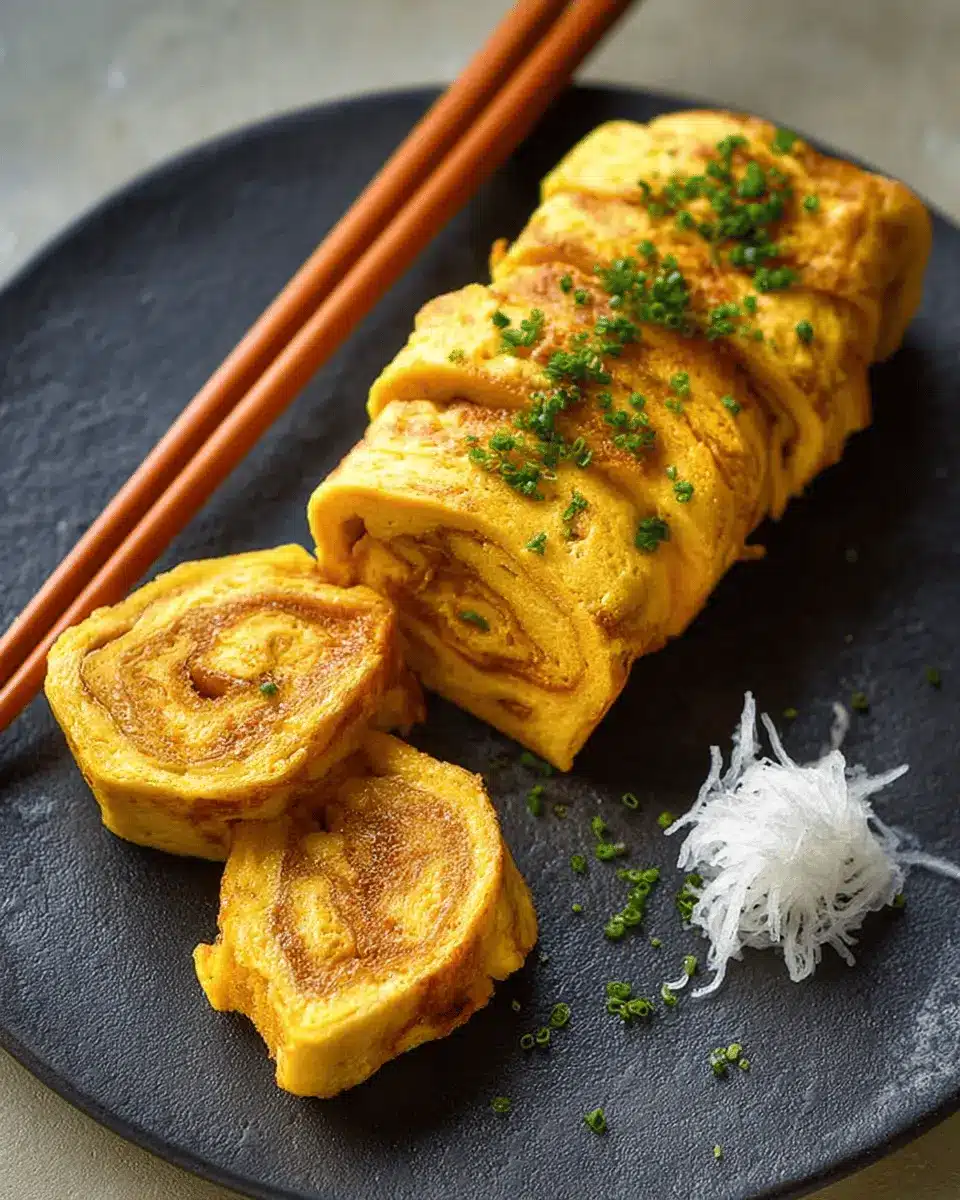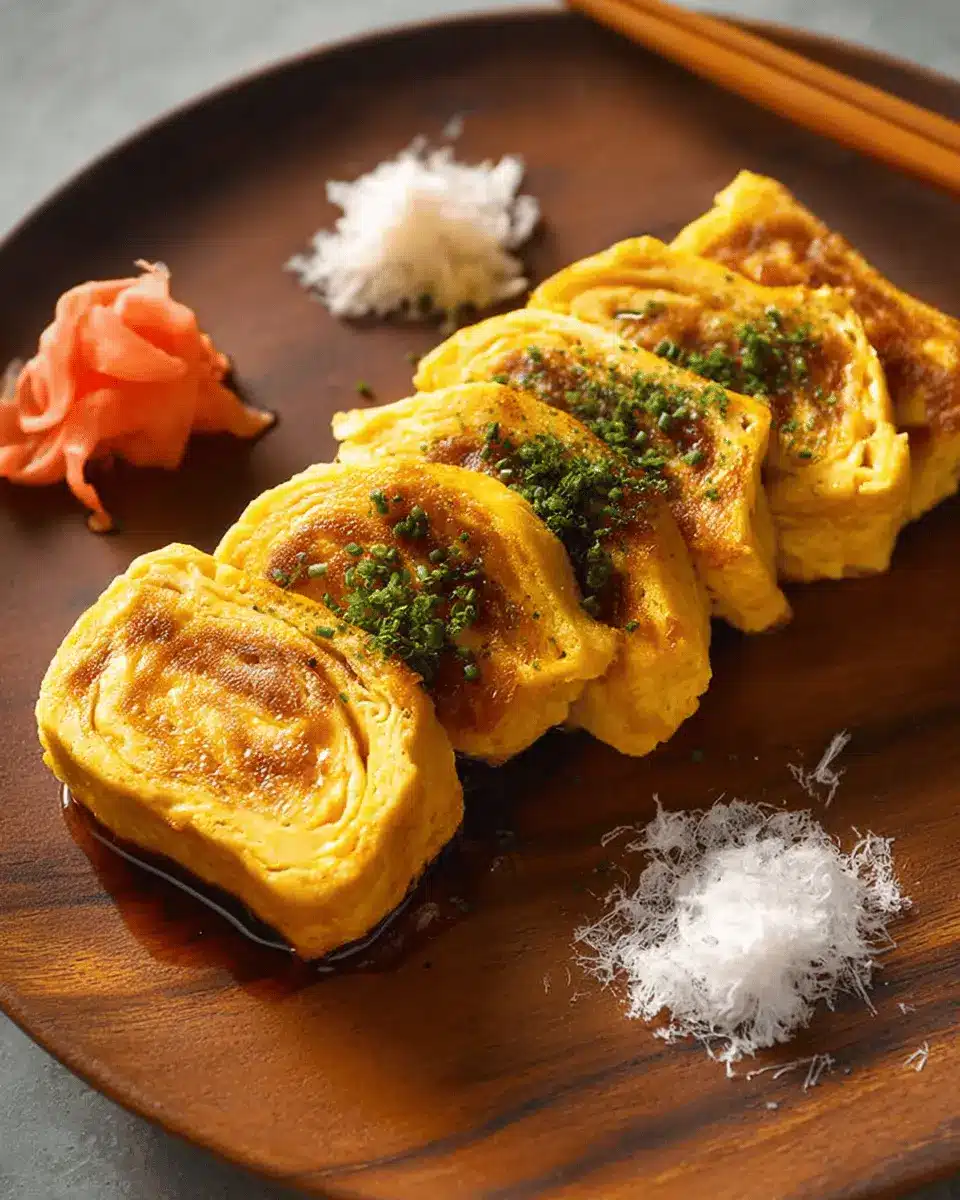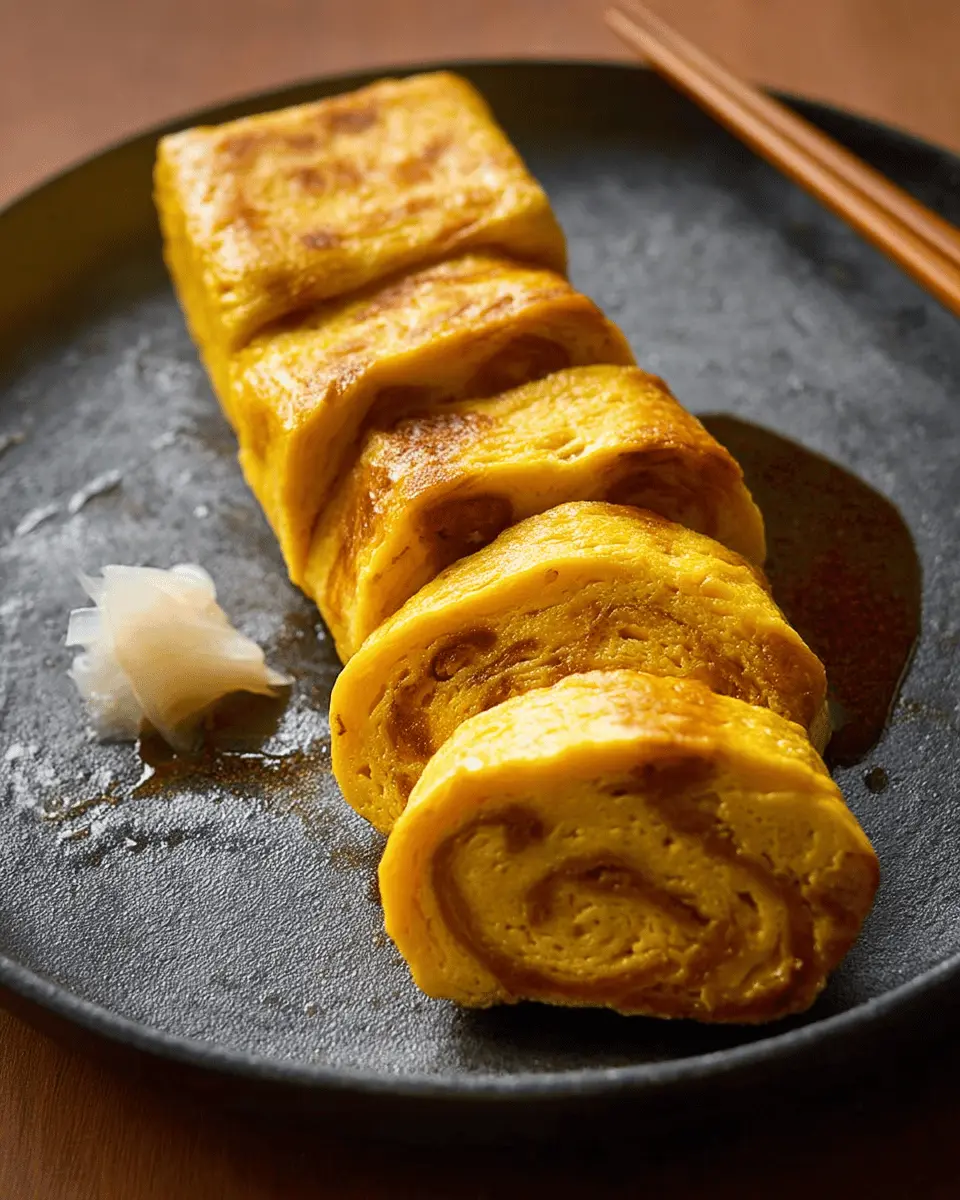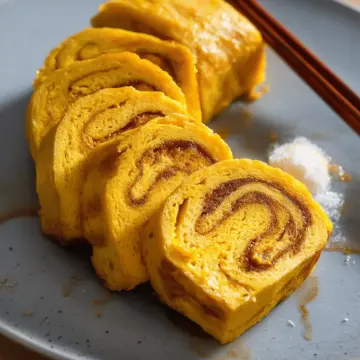Introduction to Tamagoyaki Recipe
What is Tamagoyaki and why should you try it?
If you’re diving into the vibrant world of Japanese cuisine, one dish to absolutely put on your must-try list is Tamagoyaki, or Japanese rolled omelet. This delectable creation is not only a staple at sushi bars but also makes for a versatile addition to your breakfast or bento boxes. Unlike a standard omelet, Tamagoyaki features layers of tender, slightly sweet egg that are expertly rolled into a beautiful, cylindrical shape.
Why should you try this Tamagoyaki recipe? For starters, it’s a fantastic breakfast option that elevates a simple egg dish into something special. The mix of mirin sweetening the eggs and the savory depth from hondashi (a powdered bonito stock) creates a flavor profile that’s both unique and comforting. Plus, making it at home allows you to customize ingredients to your taste!
Have you ever felt intimidated by Japanese cooking? You’re not alone! But fear not—this recipe is straightforward and fun, perfect for beginner cooks. With just a few ingredients and a little bit of practice, you’ll impress your friends and family with this culinary delight. So, grab your eggs, and let’s roll!

Ingredients for Tamagoyaki
Necessary ingredients for a delicious Tamagoyaki
To create a perfect tamagoyaki recipe, you'll need some essential ingredients that bring this Japanese rolled omelet to life:
- 6 large eggs: The foundation of your tamagoyaki. Fresh eggs offer the best flavor and texture.
- 1 tablespoon mirin: A sweet rice wine that adds depth and uniqueness.
- 1 teaspoon granulated sugar: Balances the savory elements and enhances the egg's sweetness.
- ½ teaspoon kosher salt: Essential for seasoning and elevating the dish.
- ½ teaspoon hondashi: This powdered bonito stock or dashi base imparts a delightful umami flavor.
- ½ teaspoon toasted sesame oil: Adds a hint of nuttiness and richness.
- Cooking spray or 1 teaspoon neutral oil: For greasing the pan and preventing sticking.
Optional ingredients for personalized twists
Feel free to get creative! Consider adding these optional ingredients to give your tamagoyaki a unique twist:
- Green onions: Chopped finely, they provide a fresh crunch.
- Shredded nori: Adding a hint of ocean flavor.
- Chicken ham or turkey bacon: For added protein if you're looking to make it more filling.
- Cheese: A sprinkle of your favorite cheese can deliver a creamy surprise.
With these ingredients in hand, you'll be well on your way to mastering this delightful dish! Want more tips on perfecting your technique? Check out Just One Cookbook for insights into authentic Japanese cooking.
Step-by-Step Preparation of Tamagoyaki
Creating the perfect Tamagoyaki recipe—a delightful Japanese rolled omelet—might seem daunting at first, but with a little patience and some guidance, you’ll have a beautifully layered dish that impresses family and friends alike. Let’s dive into the steps!
Gather Your Ingredients
Before embarking on your culinary adventure, it’s crucial to gather all your ingredients. Here’s what you’ll need:
- 6 large eggs
- 1 tablespoon mirin – this sweet rice wine adds depth to your omelet.
- 1 teaspoon granulated sugar – for a touch of sweetness.
- ½ teaspoon kosher salt – to balance flavors.
- ½ teaspoon hondashi (optional) – this powdered bonito stock enhances the umami taste.
- ½ teaspoon toasted sesame oil – for a nutty aroma.
- Cooking spray or 1 teaspoon neutral oil (like canola or vegetable) – for a non-stick pan.
Having everything ready saves time and allows you to focus on perfecting your Tamagoyaki technique.
Whisk the Egg Mixture
In a medium bowl, combine all your ingredients and whisk the mixture using chopsticks or a fork. Make sure there are no streaks of egg white remaining. This blending is vital for achieving a silky texture in your Tamagoyaki.
Strain the Egg Mixture
To ensure a smooth, lump-free omelet, pour the egg mixture through a fine-mesh strainer into another bowl. This process may take several minutes, so be patient! Discard any solid bits left in the strainer. Straining helps achieve that instagrammable smoothness.
Heat Your Tamagoyaki Pan
Next, heat your tamagoyaki pan or a medium nonstick pan over medium-low heat. Coat the pan lightly with cooking spray or a teaspoon of oil. This step ensures that the omelet will easily release from the pan once fully cooked.
Cook the First Layer
Pour about 3 tablespoons of the egg mixture into the pan, quickly tilting it to ensure even coverage across the surface. Cook until the egg is about 80% set, which usually takes about 3-4 minutes. Patience is key here!
Roll the Omelet
Once it’s almost set, it’s time to roll! Starting from the end of the pan furthest from you, use chopsticks or flexible spatulas to gently roll the cooked egg toward you. This creates the first layer of your delicious Tamagoyaki. Slide the rolled portion to the top of the pan; keep it warm while preparing the next layers.
Repeat Cooking and Rolling
Add another thin layer of the egg mixture, lifting the rolled omelet to allow the uncooked egg to flow underneath. Repeat the cooking and rolling process until you’ve used up the entire egg mixture. Aim for 5 to 6 batches in total for the best thickness.
Cool and Slice the Tamagoyaki
Transfer your beautifully rolled omelet to a cutting board, seam-side down. Allow it to cool for about 5 minutes. Once cooled, cut it crosswise into ½-inch or 1-inch-wide pieces. Each slice will reveal the lovely layers you’ve crafted!
With these careful steps, you’re now equipped to make a perfectly layered Tamagoyaki. Whether served as a side dish or as part of a bento box, your efforts will surely pay off. Happy cooking!

Variations on Tamagoyaki
Sweet Tamagoyaki
For those with a sweet tooth, sweet tamagoyaki is a delightful twist on the classic dish. By increasing the sugar and adding a splash more mirin, you create a subtly sweet flavor that shines in breakfast or as a dessert. This version is especially popular among children and pairs well with a dollop of fruit preserves or a sprinkle of powdered sugar for an inviting finish. Imagine enjoying a slice with a cup of green tea—pure bliss!
Savory Veggie Tamagoyaki
If you’re looking for a nutritious twist, consider savory veggie tamagoyaki. Simply stir in finely chopped vegetables like scallions, bell peppers, or spinach into the egg mixture before cooking. This adds color, flavor, and a healthy dose of vitamins, making it perfect for a balanced meal. Plus, it’s a great way to sneak in extra veggies if you’re feeding picky eaters! Adding a bit of grated cheese or a sprinkle of sesame seeds can elevate the taste even further.
These variations showcase how versatile the tamagoyaki recipe can be—endless possibilities await!
Cooking Tips and Notes for Tamagoyaki
Importance of the Right Pan
Using a traditional tamagoyaki pan, or a rectangular nonstick skillet, is essential for achieving that iconic rolled shape. The smaller size helps control your egg layers and ensures even cooking. If you’re in the market for a new pan, consider exploring options like Tamagotcha pans, which are designed specifically for this purpose.
Tips for Perfect Rolling
Rolling tamagoyaki can be tricky but rewarding! Start by making thin layers of eggs to ensure they cook through before rolling. Use chopsticks or two flexible spatulas for better control. Remember, practice makes perfect: the more you roll, the better you’ll get at finding that sweet spot between tenderness and firmness. Don't be afraid to experiment to make your perfect tamagoyaki!

Serving Suggestions for Tamagoyaki
How to serve it for breakfast or brunch
Tamagoyaki makes a delightful addition to your breakfast or brunch spread. Serve it hot or at room temperature, sliced into bite-sized pieces. Place it on a bed of steamed rice for a classic touch, or alongside fresh fruit for a colorful plate. Pairing with a steaming bowl of miso soup can elevate the meal further, adding warmth and comfort.
Pairing ideas with sides or sauces
For a more robust experience, consider serving tamagoyaki with sides like sautéed greens or a light salad. Drizzle a soy sauce or sweet teriyaki glaze on top for added flavor. If you're feeling adventurous, a dollop of wasabi or a tangy ponzu sauce can provide a delightful contrast, enhancing the sweet-savory profile of your tamagoyaki recipe.
These simple yet thoughtful touches can turn your tamagoyaki into a centerpiece worthy of any gathering!
Time Breakdown for Tamagoyaki
Preparation Time
Getting everything ready for this Tamagoyaki recipe is a snap! You’ll need about 5 minutes to gather and whisk your ingredients.
Cooking Time
The magic happens in the skillet, requiring 20 minutes to cook all those delicious layers to perfection.
Total Time
All said and done, you’re looking at a total of 25 minutes from start to finish. Perfect for a quick breakfast or an impressive brunch with friends!
This rolled omelet is not just a delightful dish; it's also a mindful cooking experience. Did you know that making Tamagoyaki can be a calming meditative practice? The careful rolling of each layer, combined with the delightful aroma, truly makes it worth the time. For more tips on enhancing your culinary skills, check out this fantastic resource. Happy cooking!
Nutritional Facts for Tamagoyaki
Calories per serving
A serving of this delicious tamagoyaki contains approximately 230 calories. If you're watching your caloric intake, this dish provides a satisfying option without tipping the scales.
Protein content
Each serving packs in about 14 grams of protein, thanks to the eggs. This makes tamagoyaki not only a tasty treat but also a great choice for a protein boost!
Sodium levels
When it comes to sodium, you'll find about 380 mg per serving. While it’s reasonable for a savory dish, consider pairing it with fresh veggies to keep things balanced. Want to learn more about sodium intake? Visit the American Heart Association for in-depth information.
FAQ about Tamagoyaki
What’s the secret to a fluffy Tamagoyaki?
To achieve a fluffy Tamagoyaki, the key lies in the technique! Start with a well-blended egg mixture, ensuring there are no streaks of egg white. Straining the mixture through a fine-mesh sieve helps eliminate any lumps, making for a smooth texture. Cooking on low heat is also crucial; it allows the egg to set gently without browning. Lastly, the technique of rolling the omelet as you cook maximizes the fluffiness, creating those delightful layers.
Can I make Tamagoyaki ahead of time?
Absolutely! Tamagoyaki can be made in advance and stored in the refrigerator for up to three days. Be sure to let it cool completely before wrapping it in plastic wrap to keep it fresh. When ready to serve, you can either eat it cold or give it a quick reheat in a pan. This time-saving method is perfect for busy weekday mornings or for adding to a bento box!
What if I don’t have a tamagoyaki pan?
No worries if you don’t have a tamagoyaki pan! You can use a regular non-stick skillet instead. Just keep the cooking technique the same. The key is to pour the egg mixture thinly and roll it as you go. While a square tamagoyaki pan gives that classic shape, a round pan will work just fine. If you're interested in exploring more about equipment, check out this guide on kitchen essentials.
Conclusion on Tamagoyaki
Final thoughts on making your own Tamagoyaki at home
Crafting your own Tamagoyaki is not just about skill—it's about joy and taste! This delightful Japanese rolled omelet brings a unique texture and flavor to any meal. With this Tamagoyaki recipe, you can impress guests, enhance breakfast, or even elevate your bento box. Give it a try!

Tamagoyaki (Japanese Rolled Omelet)
Equipment
- tamagoyaki pan
- fine-mesh strainer
Ingredients
- 6 large eggs
- 1 tablespoon mirin
- 1 teaspoon granulated sugar
- ½ teaspoon kosher salt
- ½ teaspoon hondashi powdered bonito stock or dashi base
- ½ teaspoon toasted sesame oil
- 1 teaspoon neutral oil such as canola or vegetable
Instructions
- Place 6 large eggs, 1 tablespoon mirin, 1 teaspoon granulated sugar, ½ teaspoon kosher salt, ½ teaspoon hondashi, and ½ teaspoon toasted sesame oil in a medium bowl. Whisk with chopsticks or a fork until no streaks of egg white remain.
- Pour the mixture through a fine-mesh strainer into another bowl, swirling the strainer occasionally (this might take a few minutes). Discard the contents of the strainer.
- Heat a tamagoyaki pan or medium nonstick pan over medium-low heat. Coat the pan with a thin layer of cooking spray or 1 teaspoon neutral oil. Pour a thin layer of the egg mixture into the pan (about 3 tablespoons), quickly tilting the pan so that the egg mixture covers the entire surface.
- Cook until the egg mixture is almost set (about 80%), 3 to 4 minutes. Roll it up, starting at one short end of the tamagoyaki pan furthest away from you, and using chopsticks or two flexible spatulas, roll it down on itself toward you. Slide the rolled omelet to the top of the tamagoyaki pan.
- Pour another thin layer of egg mixture into the pan, lifting the already-rolled portion up to let the mixture flow underneath. Repeat cooking and rolling until you use up the egg mixture (5 to 6 batches).
- Transfer the omelet seam-side down to a cutting board. Let cool for 5 minutes. Cut crosswise into ½-inch or 1-inch-wide pieces.





Leave a Reply